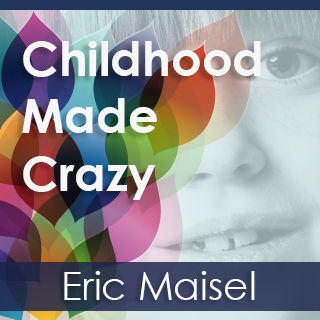
Welcome to Childhood Made Crazy, an interview series that takes a critical look at the current “mental disorders of childhood” model. This series is comprised of interviews with practitioners, parents, and other children’s advocates as well as pieces that investigate fundamental questions in the mental health field. Visit the following page to learn more about the series, to see which interviews are coming, and to learn about the topics under discussion:
http://ericmaisel.com/interview-series/
Paula J. Caplan is a clinical and research psychologist, activist and advocate, award winning nonfiction writer, playwright, and screenwriter. She is currently Associate at the DuBois Institute, Harvard University and blogs at paulajcaplan.net, Psychology Today, psychdiagnosis.weebly.com, and whenjohnnyandjanecomemarching.weebly.com. Her books include Bias in Psychiatric Diagnosis and They Say You're Crazy
Paula shared with me the following:
One of the most important learning experiences I ever had was this: Decades ago, a psychiatrist I respected greatly asked if I would see a child whom he had seen, because he had no idea what was happening with the child or how to advise the parents.
The parents brought the little boy — who as I recall was almost three years old — to my office and told me that he had never spoken but was happy and affectionate. They were beside themselves with worry, because they believed that if the child were properly diagnosed, the solution would be clear.
The many different professionals to whom they had taken him had suggested different psychiatric labels, and the parents were especially afraid that he was “autistic,” but they had looked in the widely used psychiatric diagnostic manual, the Diagnostic and Statistical Manual of Mental Disorders, and had seen that he did not meet all of the requisite criteria for that label.
I spent some time taking a detailed history of the child from his mother and father, testing him as well as I could, and observing him carefully. Then I told the parents that they were right that he did not fit the DSM listing for autism, that I heard nothing in the history that might explain why he was not speaking, that I did not know of any certain way to get him to speak, and that there was no way I knew of even to predict whether or not he would eventually speak – and if he would, when that might begin.
I had assumed that the parents would be upset by what I told them, but their reaction was one of great relief. They said that they had read everything they could find about this subject and had not found anything that shed light on their child’s difficulty, and they had therefore been dismayed when so many professionals tossed out various psychiatric labels and recommendations for treatment, when they knew that the criteria for those labels failed to fit their child. So it was a good experience for them to hear from me what I did not know, because they were tired of people trying to pretend they knew what was happening.
I explained to them that I had learned that psychiatric categories are not, as was widely believed due to false advertising, solidly based in high-quality science. That statement had credibility because I told them that I had served for two years on two committees that were creating the fourth edition of the DSM and had seen with my own eyes that the manual’s authors often ignored, distorted, even lied about good scientific research if it failed to support what they chose to include or exclude, as well as that they often presented junk science as though it were good science if that could be used to support their decisions.
I said that the hundreds of categories of DSM disorders had been constructed by a small number of mostly white, male, American psychiatrists who shared many beliefs about what should and should not be called mental disorders and that their choices were akin to decisions about which celestial stars to “connect” in order to form constellations. I explained that it had been proven that two therapists seeing the same patient had a high probability of given that patient different DSM labels and that one patient seen over time often got very different labels at different points.
I said that human behavior is so multiply determined and complex that it is often impossible to know what caused a particular problem or difference and that the labels had not been helpful at identifying causes or effective interventions. In other words, I explained, it was a myth that if they just got the right diagnosis, it would be clear what courses of action might be helpful.
I concluded, what was important was to look honestly at what could be known about a particular person and to think critically about relevant, high-quality research (where there is any), about what else is known (by the clinician, the person coming for help, and anyone else who could shed light) about the kinds of things that can be helpful, as well as to monitor over time – if the person or family so wishes – whether the suggested approaches are helpful and be prepared to try other things if they are not.
Crucial to my thinking in saying that was the concern about how much of what is called “treatment” is problem-focused rather than strength-focused and is pathologizing, which often adds new sources of trouble. (A troubling exception, of course, is that many school systems refuse to provide help of any kind to any child who needs it unless the child receives a pathologizing diagnosis. For such situations, parents should be advised that the reason for assigning a label is to get the child help that hopefully will be appropriate but that everything possible ought to be done to assure the child that she or he is not “crazy” or “stupid.” This is admittedly a Sisyphean task, given the damaging power of labels, but until we transform the system, it may be the best one can do.)
With the parents of that little boy, I discussed at some length the importance of ensuring that their son would not come to feel frightened or ashamed of not speaking and of building on his strengths by continuing to interact lovingly and supportively with him and teaching him – in a way free from high pressure or panic on their parts – whatever he was capable of learning, as well as continuing to provide him experiences of delight and letting them see the joy he inspired in them.
Unfortunately, I lost touch with the family, so I don’t know what became of the child. But my experience with them reinforced my belief in the importance of telling people the truth about what is and is not, what can and cannot be known about their child, so that they know that the fields of emotions and behavior are far from being grounded in hard science and need to be imbued with as much thoughtfulness, critical thinking, and humanity as possible.
As to the matter of medication, two criteria ought always to be met when any professional recommends any course of action — but they very rarely are. These are:
If I recommend X, I should disclose the full range of benefits and of adverse effects that X has been known to cause, and when X is a drug, I should explain that in lawsuits and elsewhere, many drug companies have been shown to conceal knowingly and purposefully many adverse effects, so that, try though I might I cannot be certain that I have unearthed all proof of possible harm.
If I recommend X, I should explain why and also present to them the whole range of approaches — definitely including those that do no involve drugs — that have been shown to be helpful to at least some people with the kind of problem we are trying to address in their child.
Especially pertinent to (1) is Robert Whitaker’s classic book, Anatomy of an Epidemic, in which this Pulitzer-nominated journalist scrupulously reviewed research from, among other sources, the National Institute of Mental Health and the World Health Organization, and found that every psychiatric drug helps some people sometimes for at least periods of time but harms more than it helps.
I would explain that a great many psychiatric drugs prescribed for children are prescribed “off-label,” that is, without their even having been approved by the FDA for use in children, and that this is particularly alarming, given that the FDA is often appallingly lax in the standards it sets of approving drugs even for adults. I would further report that long-term studies of drug effects are exceedingly rare, so that the effects on developing infants, children, and adolescents tend to be largely or entirely unknown. And I would say that what are also almost entirely unstudied are the interactions between two drugs and among three or more. In light of these serious problems, parents need to know, their children are in important senses guinea pigs when taking psychotropic drugs.
Professionals who prescribe medication (psychotropic or otherwise) often take what I consider the deeply unethical view that they should not alert parents or children about possible negative effects from the drug. They often give as the “reason” that if you tell them the bad things that might happen, they may imagine that the drug is having those adverse effects even when it is not.
Parents should also be told that it frequently happens that a child (or adult) is put on a psychiatric drug and has adverse reactions to it but that clinicians fail to consider that these reactions are caused by the drug, leaping instead to the conclusion that “This child is sicker than I thought!” and increasing the dosage of the drug, adding another drug (nearly always a more dangerous one), adding a more serious psychiatric label to the child, or some combination of the above. Parents should be encouraged to challenge these courses of action and to insist that the possibility of adverse reactions be fully explored.
Every parent can of course choose to have their child take one or more psychiatric drugs, but they surely must be as fully informed as possible before making that choice, as with making any choice about what could be helpful to their child or harmful … or some of each.
It would be wonderful if in high school, every student were taught the differences between research – at the very least about drugs, non-drug approaches that are used in the mental health system, and the creation of psychiatric categories — that is well-designed, well-executed, and responsibly interpreted and research that is poorly done.
That would put parents in a better position to evaluate the recommendations made by service providers. At the very least, parents should know that they have the right to ask providers for references to research about what they recommend and, importantly, that even if they themselves are not clinicians or researchers, they have the ability and intelligence to read research reports and do some critical thinking about their merits.
The provider by all rights ought to offer to go over the relevant research with the parents and guide them through the process of thinking critically about their merits. But parents who are so intimidated by medical or scientific writing that they have trouble going through that process should be connected with someone who can assist them.
And what about alternative approaches? Many clinicians, teachers, and even probation officers have seen that, whereas giving a child a psychiatric label and psychotropic drugs often greases the skids into the juvenile justice system and later the adult prison system, if not into permanent enrollment in the disability system, using other kinds of approaches can be helpful, healing, and strengthening.
The heavily psychiatrized culture in which we live often makes it seem that alternative approaches cannot possibly be effective, because they seem less scientific (as though psychiatric diagnosis were scientific, and as though good science strongly supports the effectiveness and safety of psychiatric drugs) than do the traditional approaches of therapy and drugs. But there is ample evidence of the effectiveness of such approaches as involvement in any of the arts, community service, political action, physical exercise, exposure to Nature, and spiritual connections, as there is for the importance of friendship, freedom from poverty, oppression, and violence. In testimony to the Rhode Island state legislature many years ago, I spoke against cutbacks in funding for the arts in schools, saying that if every student participated in the arts from kindergarten onward, there would be far fewer people in prisons and mental hospitals.
Also powerful and effective in positive ways are explicit depathologizing and relativistic approaches. With regard to depathologizing, Dr. Vincent Felitti of the Adverse Childhood Experiences research is a laudable pioneer in switching the approach to people’s problems from asking, “What is wrong with you?” (pathologizing the sufferer) to “What happened to you?” and helping the sufferer to understand the origins of their troubles in ways that are not victim-blaming or pathologizing and making it easier to focus on what kinds of support and help will be likely to move the person beyond the effects of trauma and into a happier life.
A relativistic approach involves moving beyond the typical We/They thinking that characterizes classifying some people as mentally ill and the rest as normal. It can include making it clear to the child that their difficulties result from reacting to upsetting experiences that would upset anyone, to reduce their feeling that something must be wrong with them because of the ways they have coped with upset or trauma. Related to this, it is helpful to make it clear that what society – and traditional mental health professionals – often describe as pathology in children (and adults) can in fact be the ways they have found to cope and survive in the face of adversity and thus in an important sense have been strengths because of their survival value. Once that respect for the coping has been established, giving the child greater self-respect, it is often easier to help the child look at the ways that their coping styles may get them into difficulties they prefer to avoid and to go on to help them find less risky ways to cope.
With regard to children who have learning “disabilities” or differences, the relativistic approach can be helpful. It involves teaching both the child who is struggling with school tasks and other children close to that child (family, classmates, neighborhood friends) that everyone of every age has relative strengths and weaknesses, that they vary enormously from one person to another, that many of these are innate and not to be ashamed of, and that those whose weaknesses fall into certain categories (school subjects especially) are the ones who are labeled with disabilities but that many other people have major problems with other kinds of tasks and abilities that happen not to be emphasized in school. This is of course a way of teaching children about the great array of individual differences that characterize human beings.
**
To learn more about this series of interviews please visit http://ericmaisel.com/interview-series/
To learn more about Dr. Maisel’s workshops, trainings and services please visit http://ericmaisel.com/
To learn more about Dr. Maisel’s guides, singles, and classes please visit http://www.ericmaiselsolutions.com/




